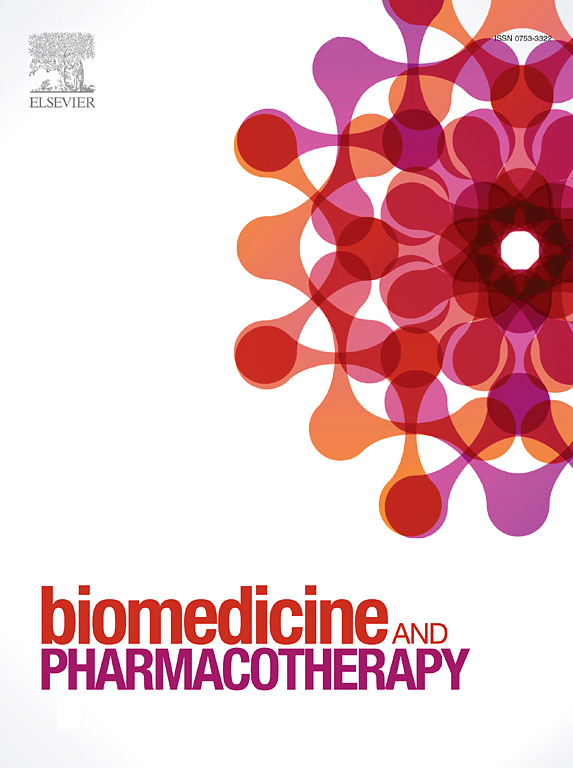APMCG-1 通过激活 PI3K/AKT 通路,减少氧化应激和细胞凋亡,促进血管生成,从而减轻缺血性中风损伤。
IF 6.9
2区 医学
Q1 MEDICINE, RESEARCH & EXPERIMENTAL
引用次数: 0
摘要
缺血性中风(IS)是全球死亡和发病的主要原因。除溶栓外,针对抗氧化凋亡和血管生成的策略也被认为是未来的治疗策略。然而,现有的自然疗法和临床疗法对治疗 IS 的疗效有限。此外,尽管人参等天然药物在治疗 IS 方面已有千年历史,但其生产成本却很高。在我们之前的研究中,从山地栽培人参药渣中提取的新型糖肽 APMCG-1 是治疗 IS 的有效候选药物。本研究利用 H2O2 诱导的氧化应激范例,在模拟缺血内皮细胞的人脐静脉内皮细胞(HUVECs)、泊那替尼诱导的斑马鱼 IS 模型和大鼠大脑中动脉闭塞(MCAO)原型中,研究了 APMCG-1 对 IS 损伤的补救机制。细胞实验证实,APMCG-1 能有效防止氧化应激和细胞死亡,促进再生,并在 H2O2 受压的 HUVECs 框架内促进血管新生。此外,在斑马鱼 IS 模型中,APMCG-1 还能提高血液动力学速度、减轻氧化应激、减少细胞凋亡和增强运动能力。在 MCAO 大鼠中,APMCG-1 可改善神经功能缺损和脑损伤,表现为神经功能评分提高和梗死面积缩小。在细胞和动物模型中,APMCG-1 激活了 PI3K/AKT 信号通路,调节了 Nrf2、Bcl-2、Caspase 3、eNOS 和 VEGFA 等因子,从而改善了细胞氧化窘迫并催化了血管生成。总之,这些结果证明了 APMCG-1 在 IS 药物治疗中的潜在保护作用,以及它作为一种草药衍生的 IS 治疗方式的前景。本文章由计算机程序翻译,如有差异,请以英文原文为准。
APMCG-1 attenuates ischemic stroke injury by reducing oxidative stress and apoptosis and promoting angiogenesis via activating PI3K/AKT pathway
Ischemic stroke (IS) is a major cause of mortality and morbidity worldwide. Beyond thrombolysis, strategies targeting anti-oxidative apoptosis and angiogenesis are considered prospective therapeutic strategies. Nevertheless, existing natural and clinical remedies have limited efficacy in the management of IS. Moreover, despite their millennial legacy of IS remediation, natural remedies such as ginseng incur high production costs. The novel glycopeptide APMCG-1, extracted from mountain-cultivated ginseng dregs in our previous study, is a potent therapeutic candidate for IS. This study investigated APMCG-1's remedial mechanisms against IS injury using an H2O2-induced oxidative stress paradigm in human umbilical vein endothelial cells (HUVECs) emulating ischemic endothelial cells, in a ponatinib-induced zebrafish IS model, and in rat middle cerebral artery occlusion (MCAO) prototypes. Cellular assays confirmed the proficiency of APMCG-1 in preventing oxidative stress and cell death, fostering regeneration, and facilitating neovascularization within the H2O2-stressed HUVECs framework. Moreover, APMCG-1 augmented hemodynamic velocity, oxidative stress mitigation, apoptosis reduction, and motor enhancement in a zebrafish model of IS. In MCAO rats, APMCG-1 ameliorated neurological deficits and cerebral injury, as evidenced by increased neurological scores and diminished infarct dimensions. In cells and animal models, APMCG-1 activated the PI3K/AKT signaling pathway, modulating factors such as Nrf2, Bcl-2, Caspase 3, eNOS, and VEGFA, thereby ameliorating cellular oxidative distress and catalyzing angiogenesis. Collectively, these results demonstrate the potential protective effects of APMCG-1 in IS pharmacotherapy and its prospective utility as an herbal-derived IS treatment modality.
求助全文
通过发布文献求助,成功后即可免费获取论文全文。
去求助
来源期刊
CiteScore
11.90
自引率
2.70%
发文量
1621
审稿时长
48 days
期刊介绍:
Biomedicine & Pharmacotherapy stands as a multidisciplinary journal, presenting a spectrum of original research reports, reviews, and communications in the realms of clinical and basic medicine, as well as pharmacology. The journal spans various fields, including Cancer, Nutriceutics, Neurodegenerative, Cardiac, and Infectious Diseases.

 求助内容:
求助内容: 应助结果提醒方式:
应助结果提醒方式:


